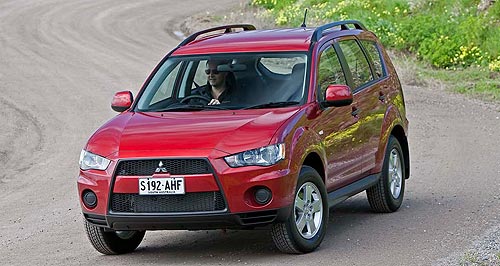First drive: Mitsubishi’s Outlander joins rush to 2WD
BY RON HAMMERTON | 3rd Dec 2010

Mitsubishi’s Outlander is the latest SUV to join the push to 2WD, slicing more than $4000 from the entry price of the country’s fifth-best-selling compact SUV.
While the AWD Outlander LS is list-priced at $33,240 in manual form, the two-wheel-drive LS manual is $4250 cheaper at $28,990 – the same price as Toyota’s two-wheel-drive RAV4 CV manual.
On the Outlander, CVT (continuously variable transmission) auto adds $2500.
Figures shown by Mitsubishi last week suggest that half of all RAV4s sold in Australia are two-wheel drive, while the 2WD component of Nissan’s Dualis has risen to some 80 per cent.
Launched as part of the updated 2011 Outlander range at the Australian International Motor Show in Sydney in October, the Outlander 2WD already accounts for 30 per cent of volume, and Mitsubishi expects that to rise steadily to about 50 per cent – a figure already achieved by its smaller SUV stablemate, the new ASX.

He said the 2WD SUV was the new wagon in the marketplace, gaining 20 per cent of the SUV market since 2004.
“It doesn’t have the stigma of a station wagon, and is more appealing to younger couples,” he said.
Mr Maxted said these “lifestyle wagons” were more affordable than the 4WD variants because they require fewer driveline parts.
So far, two-wheel drive is available only on the base Outlander LS range, providing Mitsubishi with a new sub-$30,000 price leader to appeal to a wider audience, particularly families and young couples.
Powered by the same 2.4-litre four-cylinder petrol engine that drives the AWD LS and XLS, the Outlander LS 2WD has 125kW of power at 6000rpm and 226Nm of torque at 4100rpm – figures that are almost identical to those of the rival four-cylinder RAV4.
The Mitsubishi engine comes with a choice of five-speed manual transmission or CVT auto with sports mode sequential shift.
Outlander’s optional 3.0-litre V6 – with 169kW of power and 291Nm of torque – remains the province of AWD Outlander VR and VRX models only.
By dispensing with the rear drivetrain, the 2WD Outlander slices 65kg from the kerb weight of the equivalent AWD model (1480kg v 1545kg) and has room for a bigger fuel tank – gaining an extra three litres to 63 litres.
The weight reduction has a further impact at the petrol pump, with the 2WD LS shaving 0.3 litres per 100km from the Outlander’s combined fuel consumption figure. Instead of 9.5L/100km for the manual, the 2WD version comes in at 9.2L/100km, while the CVT automatic registers 9.0L/100k instead of 9.3L/100km.
Driving only through the front wheels like a regular hatchback, the LS 2WD loses the electronically-coupled rear drive system that provides a degree of extra traction on slippery surfaces and for light off-road bush forays.
The new entry-level Outlander also misses out on the climate-control air-conditioning system and extra (side and curtain) airbags that are standard on all other models, presumably to help contain the price to the $28,990 figure of its similarly-specced major Toyota rival.
Like all Outlanders, the LS 2WD rides on MacPherson strut front suspension and multi-link rear end, and is guided by power-assisted rack-and-pinion steering.
The latest 2011 upgrade adds a full-sized spare wheel to all five-seat Outlanders in place of the space-saver that continues with the optional seven-seat configuration with its fold-away third-row rear seat.
Other tweaks for MY2011 include auto up/down function on the driver’s window and an enhanced brake-assist system for the all-wheel disc brakes (ventilated front).
Overall dimensions of the LS 2WD remain the same as the AWD models, with an identical 215mm of ground clearance. Despite the loss of the rear-drive capability, towing capacity remains at 750kg for unbraked trailers and 1500kg for braked trailers.
A multi-function display tucked between the speedo and tacho dials is standard, as is a leather-bound steering wheel with a hub containing controls for the audio system and cruise control. Remote central locking and USB port are standard.
Alloy wheels (16-inch) are standard on the LS (V6 models get bigger 18-inch alloys), as is Outlander’s split-fold tailgate that the company says makes loading items easier.